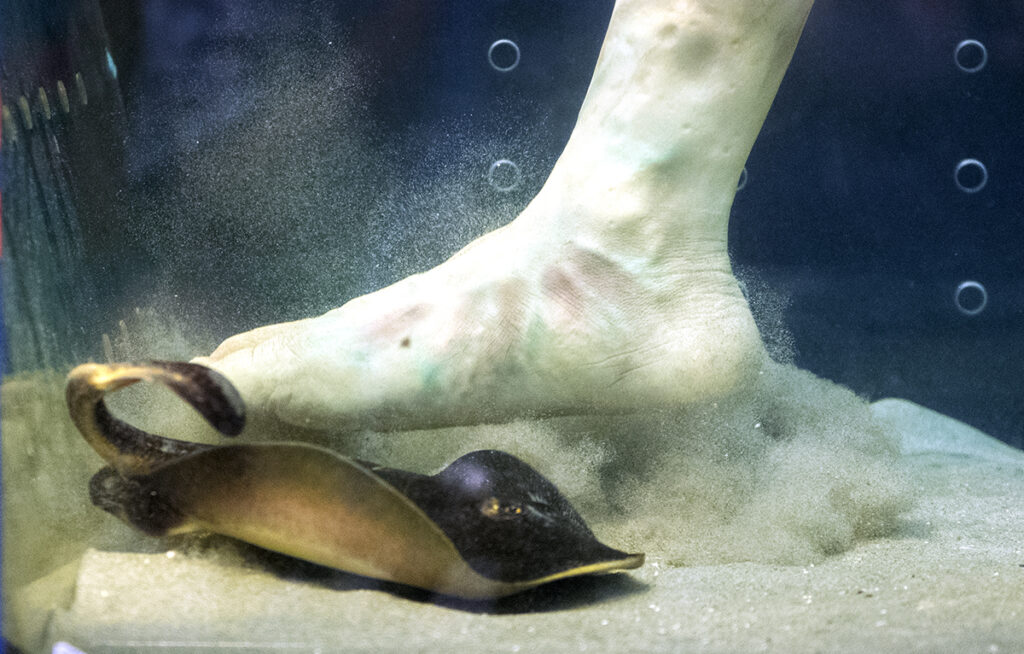
Stingray sting barb injuries are a significant concern for water enthusiasts and marine life observers alike. These injuries can lead to severe pain and complications, making it essential to understand the nature of stingrays and the risks associated with them. In this article, we will delve deep into the anatomy of stingrays, the effects of their stings, safety measures, and how to respond to sting injuries effectively.
Stingrays are fascinating creatures that inhabit shallow coastal waters around the world. While they are generally not aggressive, their defensive mechanism, the sting barb, can pose a danger to unsuspecting swimmers and divers. This article aims to provide comprehensive information about stingray sting barb injuries, including prevention strategies and treatment options. By understanding these aspects, you can enjoy your aquatic adventures while minimizing risks.
Whether you are a frequent beachgoer, a diver, or simply curious about marine life, knowing how to identify stingrays and understand their behavior can greatly enhance your safety. We will explore the biology of stingrays, the nature of their stings, and the steps you can take to avoid encounters with these enigmatic creatures.
Table of Contents
1. Biology and Behavior of Stingrays
Stingrays belong to the family Dasyatidae and are closely related to sharks. They are characterized by their flattened bodies and long, whip-like tails that contain one or more venomous spines, commonly referred to as sting barbs. Understanding the biology and behavior of stingrays is crucial for recognizing their presence in the water.
1.1 Anatomy of Stingrays
Stingrays possess a unique anatomy that allows them to thrive in their aquatic environments. Key features include:
- Flat Bodies: Their flat bodies enable them to camouflage with sandy or muddy seabeds.
- Electrosensory Organs: Stingrays have specialized organs called ampullae of Lorenzini, which help them detect electrical signals from prey.
- Venomous Spines: The sting barb, located on their tail, is used for defense against predators.
1.2 Behavior and Habitat
Stingrays are generally docile and prefer to stay hidden on the ocean floor. They inhabit shallow coastal waters, including bays, estuaries, and coral reefs. Understanding their behavior can help individuals avoid accidental encounters:
- Stingrays often bury themselves in the sand, making them difficult to see.
- They are more active during warmer months and tend to congregate in schools.
- Stingrays may become aggressive if threatened, particularly when stepped on.
2. Understanding Stingray Sting Barbs
The sting barb of a stingray is a powerful defensive tool. It is composed of a sharp, serrated spine coated in a venomous mucus. This barb can cause severe pain and injury when it comes into contact with skin.
2.1 Characteristics of the Sting Barb
Key characteristics of the sting barb include:
- Structure: The barb is made of keratin, the same material as human nails.
- Location: Typically located near the base of the tail, stingrays can have one or more barbs.
- Venom: The venom can cause a variety of symptoms, including pain, swelling, and in severe cases, infection.
2.2 Mechanism of Injury
When a stingray feels threatened, it can whip its tail and deliver a sting. The injury can vary in severity based on factors such as:
- The location of the sting.
- The size of the stingray.
- The individual's reaction to the venom.
3. Effects of Stingray Stings
Stingray stings can lead to various physical reactions, and understanding these effects can help individuals seek appropriate treatment promptly.
3.1 Immediate Effects
Upon being stung, individuals may experience:
- Intense pain at the site of the sting.
- Swelling and redness around the injury.
- Possible bleeding from the wound.
3.2 Long-term Complications
If left untreated, stingray stings can lead to:
- Infection from bacteria entering the wound.
- Severe allergic reactions in susceptible individuals.
- Chronic pain or nerve damage in extreme cases.
4. Treatment for Stingray Sting Injuries
Knowing how to treat a stingray sting can minimize pain and reduce the risk of complications. Here are the recommended steps:
4.1 First Aid Measures
Immediately after a sting, take the following steps:
- Rinse the wound with seawater to remove debris.
- Immerse the affected area in hot water (as hot as the person can tolerate) for 30 to 90 minutes to alleviate pain.
- Seek medical attention if the wound appears infected or if symptoms worsen.
4.2 Professional Medical Treatment
In cases of severe injury, medical professionals may:
- Administer pain relief medications.
- Prescribe antibiotics to prevent infection.
- Perform surgical procedures to remove any embedded barb fragments.
5. Prevention of Stingray Encounters
Preventing encounters with stingrays is crucial for minimizing the risk of injury. Here are some effective strategies:
5.1 Beach Safety Tips
When at the beach, consider the following safety measures:
- Avoid swimming in shallow waters where stingrays are likely to be present.
- Shuffle your feet instead of stepping directly into the sand to alert stingrays of your presence.
- Be cautious when wading in murky waters where visibility is limited.
5.2 Educational Awareness
Understanding stingray behavior and habitats can significantly reduce the risk of stings:
- Educate yourself and others about local marine life.
- Attend safety briefings or workshops offered at beaches or dive shops.
- Spread awareness about stingray safety among friends and family.
6. What to Do if Stung
In the unfortunate event of a sting, remain calm and follow these steps:
- Get out of the water to avoid further injury.
- Rinse the wound with seawater and seek immediate first aid.
- Monitor symptoms and seek medical attention if necessary.
7. Common Myths about Stingrays
Several myths surround stingrays and their behavior. Here are some common misconceptions:
- Myth: Stingrays attack unprovoked.
- Fact: Stingrays are typically non-aggressive and only sting when threatened.
- Myth: All stingray stings are fatal.
- Fact: While painful, most stings are not life-threatening with proper treatment.
8. Conclusion
Understanding stingray sting barb injuries is essential for anyone who enjoys water activities. By learning about the biology of stingrays
ncG1vNJzZmivp6x7o77EnKKepJxjwqx7zaiurKyimq6uhI6sq6Kml6euunnSraCnn12XrrOujaGrpqQ%3D